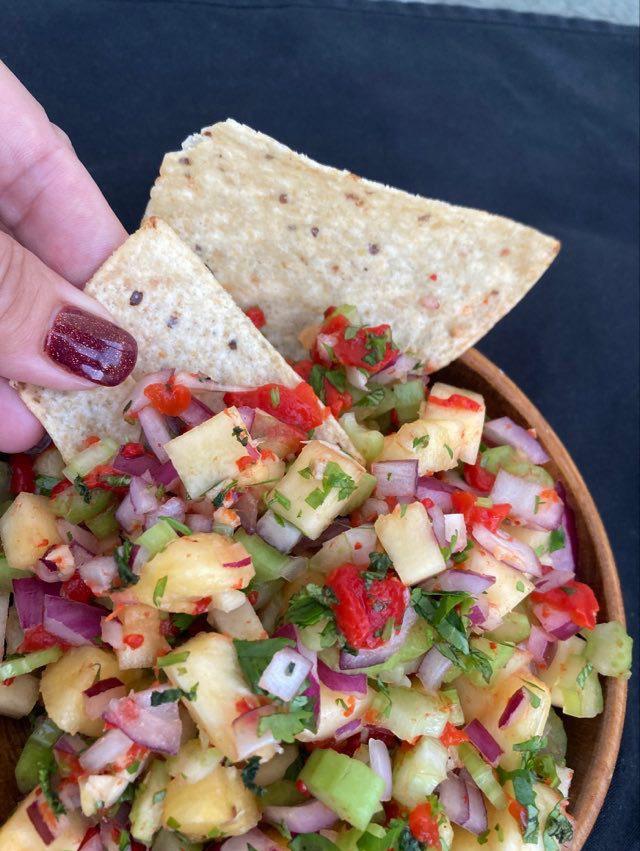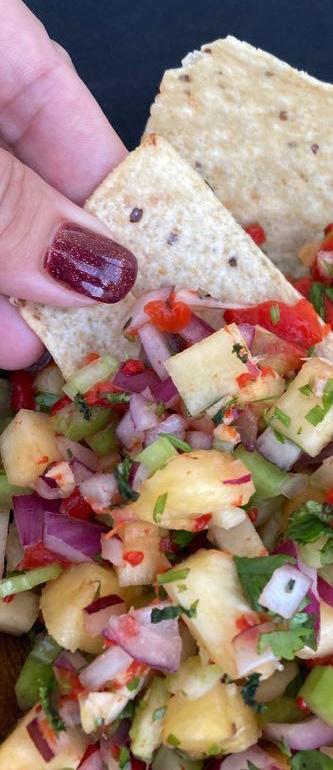
2 minute read
Gourmet Bling on a Shoestring®
Tempting Pineapple Pepper Salsa

Advertisement
Ingredients
½ of a pineapple
1 small onion
1 roasted red pepper (fresh or from a jar)
2 s talks of celery
2 large cloves of garlic
Handful of chopped, fresh coriander (or any combination of wide-leaf parsley, basil, even a lite dill)
Pinch of hot pepper (fresh or dried: being sure to cut this last, and to wash hands before touching face or anything else. Promptly wash the knife and cutting board after mincing hot pepper/s.)
2 Tbsp of white vinegar (or other)
1 Tbsp of olive oil (if you have castor oil or “vegetable oil,” STOP: throw it away. Come back with olive, coconut, safflower, grapeseed – any other oils that help and not harm the body.)
Dash salt and pepper (taste first. . . this salsa may need none or VERY LITTLE.)
Method
Serves 2-4
The trick to any good salsa is to take the time to carefully clean and chop each plant consistently in size; into neat, small, relatively even pieces. This helps you to get the Full Monty onto a chip or into one balanced mouthful.
1. Into a medium bowl, gently add all ingredients together, reserving half of the fresh herbs for last.
2. Drizzle the mix evenly with the vinegar and the oil.
3. Sprinkle with a smidge of salt and pepper if desired, then toss once - lightly.
4. Add half the fresh chopped herbs. Then toss once more, very lightly, while keeping everything intact
5. Sprinkle the top with the remaining herbs
Serve in a rustic bowl with banana chips or other flavorful “exotic” chips. Or serve as a compelling side dish for your favorite vegan, egg, fish or meat dishes.
Bear in mind: you still have the other ½ of the pineapple to use creatively and quickly. . perhaps in a blended drink to invite a little more “tropical” to your winter?
Editor’s Note:
How do you avoid the egregious, continuing gouging by the grocery industry, which has been continually profiting on the inflation that is crushing consumers’ lifestyle? Just don’t go.
1. Start with a dollar-store for nuts, dried fruits, tomato paste, brown rice, spices, frozen vegetables... you can walk out with a large bag of healthy ingredients like these for $10. (Not to mention the savings you get on zipper bags, kitchen, cooking and cleaning supplies.)
2. Stop at Big Lots or other large discount store for your coffee, and an array of pantry goods.
3. Surprise yourself at the Farmer’s Market: produce, meats and homemade breads, cheeses and desserts are less expensive than they are in most organics section of the supermarkets.
4. Find neighborhood outlet or salvage stores. They must sell safe and lower-thanretail groceries. They have endless arrays of unique and wonderful ingredients; just double check all expiration dates.
5. Go online. Get creative with your search and order great, discounted food & kitchen products to be delivered or picked up.
6. Frequent the little “mom & pop” shops in nearby neighborhoods, that often have limited inventory but great random deals.
7. Lastly, if you must go to the supermarket, be prepared: know what’s on sale. Use coupons. Don’t buy anything you don’t need. Follow only the SALE stickers & carefully compare prices PER UNIT.










